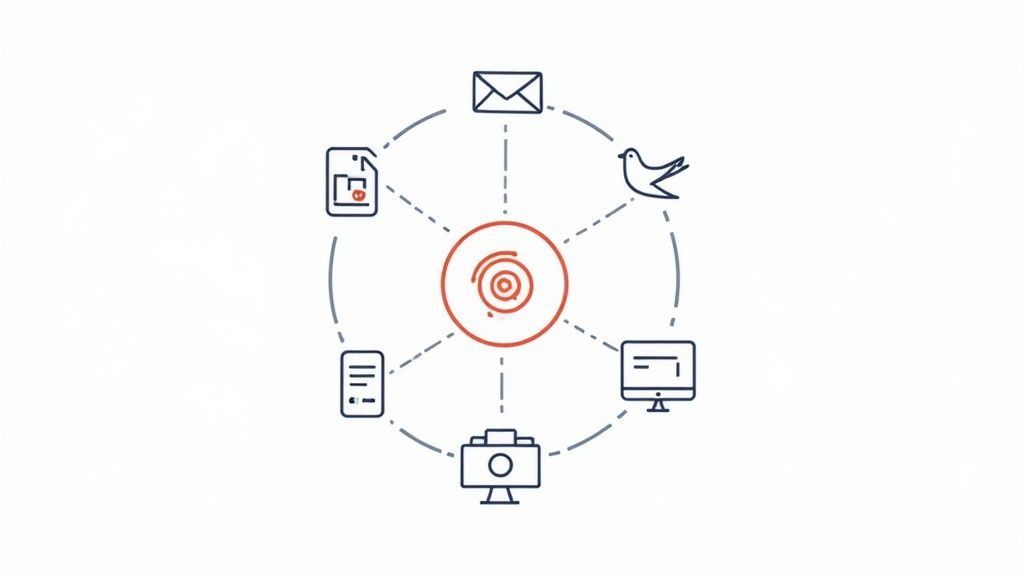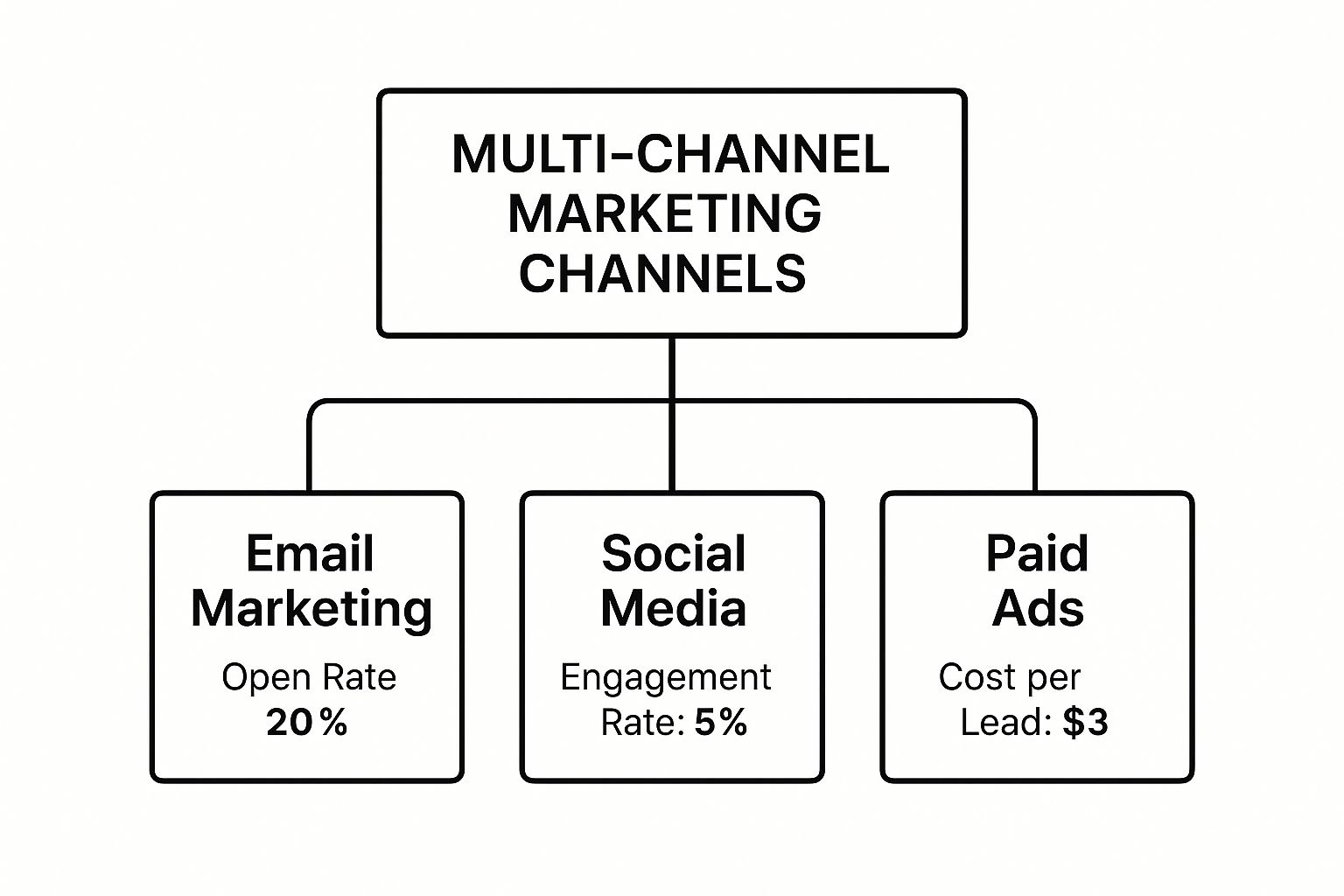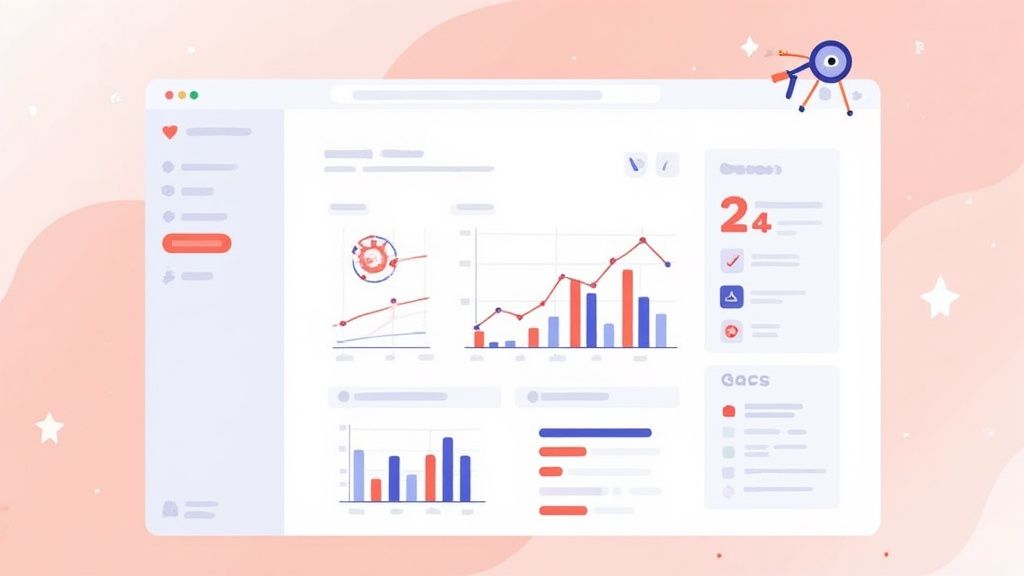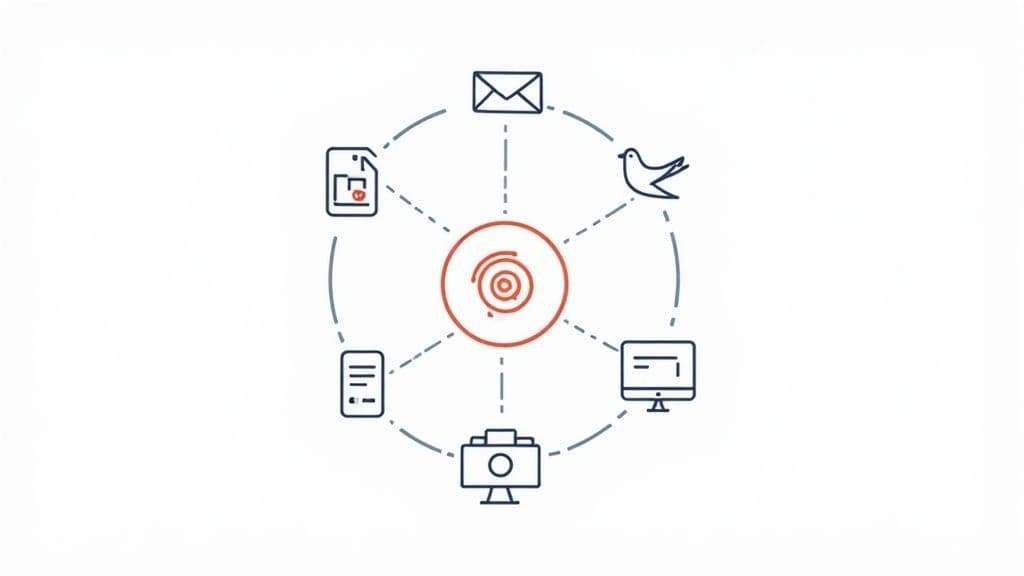Think of a multi-channel marketing strategy as a way to connect with people on their terms, not just yours. Instead of putting all your eggs in one basket—like only using social media or only sending emails—you show up in all the places your customers naturally hang out.
What Is Multi-Channel Marketing, Really?

Let's break it down without the marketing jargon. Imagine you're planning a surprise party for a friend. You might text them to see what they're up to, send a funny video on Instagram, and then email a formal invitation to everyone else. You're using different channels for different parts of the conversation, making it all feel natural and convenient.
That's the heart of multi-channel marketing. It’s not about blasting the same message everywhere. It's about giving customers the freedom to interact with your brand how they want, whether that's through your website, a mobile app, an email, or a social media post.
To really get a handle on this, it helps to have a good grasp of the basics. Understanding the fundamentals of digital marketing for beginners will show you how each channel works on its own before you start weaving them together into a cohesive strategy.
More Channels Mean More Opportunities
The biggest shift from a single-channel to a multi-channel mindset is about broadening your horizons. If your entire marketing effort is tied to a single Facebook page or a physical storefront, you're only ever going to reach the people who happen to find you there. That’s a huge limitation.
A multi-channel approach is fundamentally about customer choice. It acknowledges that the modern customer journey isn't a straight line but a web of interactions across different platforms. Your goal is to be a consistent, helpful presence at each of those touchpoints.
This isn't just theory; it's how successful brands operate today. On average, B2C marketers use at least five different channels for their campaigns. It just goes to show that to stay competitive, you need to be connecting with people across email, social media, your website, and more.
Multi-Channel vs. Single-Channel Marketing at a Glance
Laying the two strategies side-by-side really makes the difference pop. While a single-channel approach is simple, it's also incredibly fragile. A multi-channel strategy builds a far more robust and flexible presence that meets customers wherever they are.
Here’s a quick comparison:
| Aspect | Single-Channel Marketing | Multi-Channel Marketing |
|---|---|---|
| Customer Reach | Limited to users of one specific platform. | Broadened across various platforms and touchpoints. |
| Engagement | One-dimensional interaction; less flexibility for users. | Customers can engage on their preferred channel. |
| Customer Data | Provides insights from only one source. | Gathers diverse data for a richer customer view. |
| Risk Factor | High risk; if the channel fails, all marketing stops. | Lower risk; underperformance on one channel is offset by others. |
As you can see, diversifying your channels doesn't just expand your reach—it builds resilience into your entire marketing effort.
Why This Strategy Drives Real Business Growth

Let's get one thing straight: a multi-channel marketing strategy isn't just about being active on a bunch of platforms. It’s about making those platforms work together to achieve real, measurable business results. When you get this right, you create a customer experience that’s far more powerful than the sum of its parts. It’s the difference between just "doing marketing" and doing it smarter.
Think of it like a well-coached sports team. Your social media might be the scout, finding new prospects and getting them interested. Then, your email marketing steps in to build the relationship, sharing valuable content and personalized messages. Finally, a quick SMS can act as the closer, delivering a can't-miss offer that pushes them to act. Each channel has a specific job, but they all work in harmony to move the customer down the field.
Deepen Customer Relationships and Boost Engagement
One of the first things you'll notice is how much stronger your customer relationships become. When you give people the choice to interact with you on their own terms—whether that's on social media, email, or text—you're showing them you get it. This makes your brand feel less like a business and more like a partner, building trust and loyalty along the way.
And this isn't just about warm fuzzies; it creates tangible results. Companies that nail multi-channel marketing often see customer engagement metrics increase by 20-30%. It’s also common for conversion rates to jump by up to 25%. Why? Because you’re sending the right message on the right channel at the right time. You can learn more about how to boost these metrics in our guide to creating a strong social media marketing plan.
Gain Richer Data for Smarter Decisions
When your marketing channels operate in their own little bubbles, so does your data. A true multi-channel approach tears down those walls, giving you a complete picture of how customers interact with your brand. You can finally connect the dots and see how someone who found you on Instagram eventually signed up for your newsletter and made a purchase after clicking an email link.
This connected data is a goldmine. It allows you to move from making educated guesses to data-driven decisions. You gain a clearer understanding of the entire customer journey, identifying which channels are most effective at each stage and where to best allocate your resources for maximum impact.
With this holistic view, you can constantly tweak and improve your strategy. You'll know which messages hit home on which platforms, letting you optimize your content and get a much higher return on your marketing spend.
Drive Conversions and Increase Revenue
At the end of the day, marketing is about growing the business. This is where a multi-channel approach really proves its worth. By giving customers more ways to buy and keeping your brand top-of-mind across their favorite platforms, you dramatically increase your chances of making a sale.
The stats don't lie. Businesses with a solid multi-channel strategy see, on average, a 9.5% increase in annual revenue compared to those that don't. This growth comes from a few key things working together:
- Increased Touchpoints: More interactions mean more chances to turn a lead into a customer.
- Consistent Messaging: A unified brand voice across all channels builds credibility and trust.
- Targeted Promotions: You can use the perfect channel for the right offer—like email for detailed info and SMS for a flash sale—making your campaigns far more effective.
When you meet customers where they are with a message that’s both consistent and compelling, you do more than just find new buyers. You build a loyal community that fuels real, long-term growth.
Building Your Winning Strategy Framework
A great multi channel marketing strategy doesn’t just happen. It’s carefully built, piece by piece, on a solid framework—much like a blueprint for a house. Without that strong foundation, your marketing efforts can feel scattered and, frankly, ineffective. A winning framework isn't about throwing things at the wall to see what sticks; it's about putting clear pillars in place to guide every single decision.
This structure is what makes all your channels work together toward the same goal. It’s how you create a seamless and powerful experience for your audience. Let's break down the four essential components that form the bedrock of any strategy that actually gets results.
Pillar 1: Deep Audience Insight
Before you can figure out where or how to market, you have to know who you're talking to. And I mean really know them. Deep audience insight goes way beyond basic demographics like age and location. It’s about digging into the motivations, the daily frustrations, and the online habits of your ideal customer.
The best way to do this is by developing detailed customer personas. These are essentially fictional character profiles of your key audience segments. Give them names, jobs, and backstories. What are their biggest headaches? What social media apps do they scroll through on their lunch break? What kind of content actually makes them stop and listen? The more vivid you make these personas, the easier it becomes to craft messages that genuinely connect.
Pillar 2: Strategic Channel Selection
Once you know your audience inside and out, the next step is choosing the right channels to reach them. The goal isn't to be everywhere at once—that’s a surefire way to stretch your budget and your team way too thin. Instead, you need to be strategic. Focus your energy on the platforms where your target audience is already active and engaged.
This is where all that audience research really pays off. If your personas are business professionals looking for industry news, then LinkedIn and a well-crafted email newsletter are probably smarter bets than TikTok. On the other hand, if you're a B2C brand targeting a younger crowd, visual-heavy platforms like Instagram and YouTube might be your main stomping grounds.
The image below shows just how differently channels can perform, which really drives home the need for smart selection.

You can see how one channel might give you great engagement, while another delivers leads at a much lower cost. This is why you need a balanced, data-informed approach, not just a gut feeling.
Pillar 3: Cohesive Brand Messaging
Consistency is the glue that holds your entire multi-channel strategy together. Your brand’s voice, personality, and core message should feel familiar and reliable, no matter where a customer bumps into you. A person who reads a helpful, professional post on your blog should get that exact same vibe from your email newsletter and your social media updates.
Cohesive messaging builds trust. When your story stays the same across every channel, it reinforces who you are as a brand and makes you seem more credible and put-together. Inconsistencies, however, can create confusion and chip away at that hard-earned customer confidence.
To keep everything aligned, it’s a good idea to create a simple brand style guide. It should outline:
- Tone of Voice: Are you witty and informal? Or are you more professional and authoritative?
- Key Messaging Pillars: What are the 3 to 5 core ideas you want your brand to be known for?
- Visual Identity: Define your brand's colors, fonts, and rules for using your logo.
This makes sure everyone on your team is singing from the same hymn sheet, presenting a strong, unified front to the world.
Pillar 4: Unified Data Integration
This final pillar is what separates a good strategy from a truly great one. Unified data integration simply means pulling together the data from all your different channels to get a single, 360-degree view of the customer journey. Without this, each channel is its own little island, and you miss out on game-changing insights.
By connecting your data, you can track how someone interacts with your brand across multiple touchpoints. For instance, you can see that a customer first found you through a Facebook ad, then followed you on Instagram, later signed up for your newsletter via a blog post, and finally made a purchase after getting an email promotion. Seeing that whole picture is absolutely crucial for optimizing your multi channel marketing strategy and proving it's actually worth the investment.
Choosing the Right Marketing Channels for Your Brand
A winning multi-channel marketing strategy isn't about being on every single platform at once. Spreading yourself too thin is a fast track to burnout, not results. The real secret is to be smart and intentional about where you invest your time, budget, and creative firepower.
Think of it like fishing. You wouldn’t just paddle out to the middle of the ocean and randomly cast your line, hoping for the best. You’d first decide what kind of fish you want to catch, then head straight for the spots where they're known to swim. The same logic applies here—find out where your ideal customers hang out and meet them there.
Aligning Channels With Your Business Goals
Before you even start thinking about specific platforms, you need to get crystal clear on what you’re trying to accomplish. Different channels are good at different things. Using a channel for something it wasn't built for is like trying to hammer in a nail with a screwdriver—it’s just going to be frustrating and ineffective.
Your first move is to match your main business goal with a channel's natural strengths.
- Brand Awareness: If your primary objective is just getting your name out there and introducing your brand to a broad audience, channels like social media (think Instagram or Facebook) and content marketing (blogging, SEO) are fantastic. They are designed for discovery and sharing.
- Lead Generation: Need to capture contact info from people who are already interested? This is where channels like LinkedIn (for B2B), targeted paid ads, and email marketing (especially with valuable freebies) truly shine. They're built to turn initial interest into actual leads.
- Customer Nurturing: To build relationships and gently guide leads toward a sale, nothing beats email marketing. It lets you send personalized, segmented messages that build trust over the long haul.
- Direct Sales & Promotions: For driving immediate action—like for a flash sale or an event reminder—SMS and targeted social media ads are incredibly powerful. Their sense of urgency gets the job done.
Know Your Audience, Know Your Channels
Once you’ve got your goals locked down, the next step is to look at them through the lens of your audience. Who are you actually talking to? Your customer personas should be your north star, telling you exactly where your audience spends their time and what kind of content they actually want to see.
For instance, a B2B software company aiming to connect with tech executives will get much more bang for their buck on LinkedIn than on Instagram. On the flip side, a direct-to-consumer fashion brand will find its home on visually-driven, community-focused platforms like Instagram and TikTok. Getting this wrong is one of the most common pitfalls when building a multi-channel plan.
Choosing the right channel isn't about what's popular; it's about what's effective for your audience. The goal is to create a channel mix that feels natural and valuable to your customer, not intrusive.
To pull this off, a well-thought-out content strategy for social media is a must. It forces you to think critically about which platforms truly align with your brand's voice and what your audience actually wants from you.
A Closer Look at Top Marketing Channels
To help you decide, here’s a quick guide to selecting the best marketing channels based on what you’re trying to achieve and who you're talking to.
Which Marketing Channel Is Right for You?
| Channel | Best For | Audience Type | Content Focus |
|---|---|---|---|
| Email Marketing | Nurturing leads, customer retention, and direct promotions. | Engaged subscribers who have opted-in to hear from you. | Valuable newsletters, personalized offers, and company updates. |
| Social Media (e.g., Instagram) | Building community, visual storytelling, and brand awareness. | B2C audiences, younger demographics, lifestyle brands. | High-quality images, short-form video (Reels), and user-generated content. |
| Social Media (e.g., LinkedIn) | B2B lead generation, building authority, and networking. | Professionals, B2B decision-makers, and industry experts. | Thought leadership articles, company news, and professional case studies. |
| SEO & Content Marketing | Attracting organic traffic and answering user questions. | Audiences actively searching for solutions and information. | In-depth blog posts, how-to guides, and informational articles. |
| SMS Marketing | Time-sensitive promotions, appointment reminders, and alerts. | Highly engaged customers who have given express consent. | Short, urgent messages with clear calls-to-action (CTAs). |
Remember, these channels work best when they support each other, not when they’re operating in separate silos.
By carefully analyzing your goals, truly understanding your audience, and picking a focused mix of channels, you can finally move from a scattered, "spray and pray" approach to a strategic one. That focus is what allows you to create high-impact campaigns that deliver real, measurable results for your business.
Your Step-By-Step Implementation Plan

Alright, this is where theory gets its hands dirty and a great multi-channel marketing strategy starts to pay off. It's one thing to understand the concepts, but the real magic happens when you have a clear roadmap to follow. This five-step plan is your blueprint for moving from the drawing board to a real-world campaign that gets results.
Think of it like building a piece of furniture. You wouldn't just start screwing pieces together randomly. You'd look at the picture of the final product (your goals), lay out all the parts (your channels and content), and then follow the instructions step-by-step. Let's get building.
Step 1: Define Your Core Objectives
First things first: what does "success" actually look like for you? Before you write a single social media post or design one email, you need to know what you're aiming for. Vague goals like "get more sales" are just wishes. You need concrete targets to guide your decisions.
Get specific. Ask yourself the tough questions:
- Are we trying to generate 100 new qualified leads every month?
- Is our goal to bump up the website's conversion rate by 15% this quarter?
- Do we want to improve customer retention by 10% in the next six months?
These clear, measurable objectives become your North Star. They tell you which channels matter most and how you'll judge whether your multi-channel marketing strategy is actually working. Without them, you're just making noise.
Step 2: Map Your Customer's Journey
Next, you need to walk a mile in your customer's shoes. The modern path to purchase isn't a straight line—it's more like a winding road with stops at different channels along the way. Your job is to understand that journey so you can show up at the right places at the right times.
Break down the typical stages your customers go through:
- Awareness: How do they first hear about you? Maybe it's a blog post they found on Google, a Facebook ad that caught their eye, or a friend's recommendation.
- Consideration: Once they know you exist, what do they do next? They might be reading reviews, downloading a helpful guide from your site, or signing up for your newsletter to learn more.
- Decision: What finally convinces them to buy? It could be a timely email with a special offer, a retargeting ad that reminds them what they were looking at, or even an SMS with a discount code.
Mapping this out shows you which channels are most influential at each stage, which is crucial for creating a smooth experience and putting your resources where they’ll have the most impact.
Step 3: Craft Channel-Specific Content
Now that you know your goals and your customer's path, it’s time to create content. The biggest mistake I see people make is copy-pasting the same message everywhere. Effective marketing means tailoring your content to fit the platform.
For example, let's say you're launching a new product. Your campaign could look something like this:
- Instagram: A slick, eye-catching Reel showing the product in action.
- Email: A detailed newsletter to your subscribers, explaining the product's benefits and offering an exclusive launch discount.
- Blog: A deep-dive article that solves a problem your product addresses, loaded with keywords to attract organic search traffic.
When you adapt your message for each channel, it feels more native and relevant, making your entire strategy more powerful.
Step 4: Execute and Integrate Your Campaigns
With your content prepped, it's go-time. This phase is all about coordination. Using a scheduling tool like Postiz can be a lifesaver here, letting you plan and publish your content across different channels from one central hub. It’s the key to making sure your timing is perfect and your message is consistent.
But it’s also about making your channels work together. For instance, a social media post can drive people to a landing page, where they sign up for your email list. This is where you can get smart with automation. Exploring different marketing automation strategies lets you set up workflows that nurture new leads automatically, saving you tons of time while keeping your audience engaged.
Step 5: Measure and Optimize Performance
Your campaign is live. Great! But you're not done. The final, and arguably most important, step is to track your results, learn from the data, and make improvements. This is a continuous cycle.
The global market for multi-channel marketing hubs was valued at around USD 6 billion in 2024, and that number is climbing fast. Why? Because businesses need tools that bring all their data together and show them what's actually working.
Use your analytics to answer the big questions. Which channel is bringing in the most valuable customers? Where are you seeing the best engagement? Use those insights to do more of what works and tweak what doesn't. This feedback loop is what separates a good strategy from a truly great one.
Got Questions About Multi-Channel Marketing? We’ve Got Answers.
As you start piecing together your multi-channel marketing strategy, you're bound to run into some questions. It's a world filled with similar-sounding terms and tricky challenges. Let's clear the air and tackle some of the most common points of confusion head-on.
Think of this as your go-to guide for getting past the practical hurdles. We'll give you straight answers to help you move forward with confidence and turn your plan into a real success.
Multi-Channel vs. Omnichannel: What's the Real Difference?
This is easily the question I hear most often—and for good reason. The terms get thrown around interchangeably, but they're built on two totally different ideas. Nailing this distinction is critical for setting the right goals.
Here's an analogy I like to use: Imagine a shopping mall.
A multi-channel approach is like having separate, independent stores. You can visit the shoe store, then the clothing store, then the food court. Each offers a complete experience on its own, but they don’t really talk to each other. What you did in the shoe store has no impact on your visit to the clothing store. Each channel works in its own little world.
An omnichannel approach, on the other hand, connects everything. In this mall, you could try on shoes, find they don't have your size, and the salesperson could instantly check the inventory of another branch and have it shipped to your house. The channels aren't just available; they're integrated and work together to create one smooth journey for you.
In short: Multi-channel is about giving customers choices on where to find you. Omnichannel is about unifying those choices into a single, seamless customer experience. Both are valuable, but omnichannel is a more advanced evolution that demands deep data integration.
Honestly, a solid multi-channel strategy is usually the foundation you need before you can even think about going omnichannel.
How Do I Measure the ROI of This Strategy?
You have to justify your marketing spend. It’s that simple. If you can’t prove that your multi-channel marketing strategy is bringing in a return on investment (ROI), getting budget approval or buy-in from leadership is an uphill battle. The key is to stop looking at metrics in isolation and start seeing the bigger picture.
Sure, tracking individual channel stats like email open rates or social media likes is important. But measuring true multi-channel ROI is about connecting the dots between them. This takes a different mindset and, often, the right tools.
Here’s a practical way to think about it:
- Nail Down Your Main Goal: What’s the one thing you ultimately want customers to do? It could be making a purchase, booking a demo, or signing up for a newsletter. That’s your primary conversion.
- Use Attribution Modeling: This is just a fancy way of giving credit to the different touchpoints a customer interacts with. Instead of saying the last click gets all the glory, attribution models spread the credit across the entire journey. Some common models include:
- First-Touch: The first channel a customer ever found you through gets 100% of the credit.
- Last-Touch: The very last thing they clicked before converting gets all the credit.
- Multi-Touch: Credit is shared across several touchpoints, giving you a much more realistic view of what’s working.
- Calculate Customer Lifetime Value (CLV): A great multi-channel strategy doesn't just get you a sale; it creates loyal customers who stick around. By tracking the total revenue a single customer generates over time, you can see the true long-term impact of your efforts.
Measuring ROI isn't about one magic number. It's about telling a compelling story with a mix of attribution data, CLV, and channel-specific KPIs that shows exactly how your strategy is growing the business.
What Are the Biggest Hurdles to Overcome?
Let's be real—rolling out a multi-channel strategy isn't always smooth sailing. Knowing the common roadblocks ahead of time helps you prepare for them instead of being blindsided.
From what I've seen, most businesses run into these three major hurdles:
- Maintaining Consistency: Keeping your brand voice, messaging, and visuals consistent across every single channel is tough. It takes serious internal coordination and crystal-clear brand guidelines that the whole team lives and breathes.
- Data Silos: This one is a monster. When your email data lives in one system, your social media stats in another, and your website traffic in a third, you can't get a single, clear picture of your customer. Tearing down these walls—usually with a tool like a Customer Relationship Management (CRM) system—is a must.
- Resource Strain: Juggling multiple channels costs time, money, and talent. Small teams can get stretched thin fast, trying to create fresh content for every platform. The best advice? Be realistic. Start small with the two or three channels where your audience hangs out most. Master those first, then expand when you have the capacity.
Getting past these challenges is a marathon, not a sprint. If you focus on clear guidelines, invest in tools that bring your data together, and start with a manageable workload, you can build a multi-channel marketing strategy that grows right alongside your business.
Ready to bring your social media channels together and run a winning strategy from one powerful dashboard? With Postiz, you can schedule content, generate AI-powered ideas, and track performance without breaking a sweat. Stop hopping between tools and start building a brand presence that truly connects.
Discover how Postiz can simplify your multi-channel marketing





